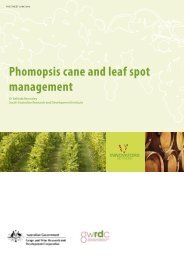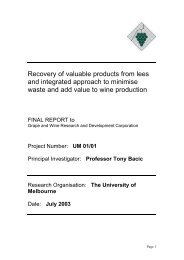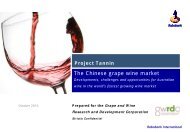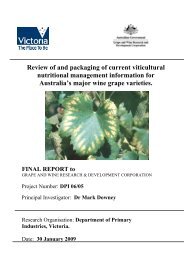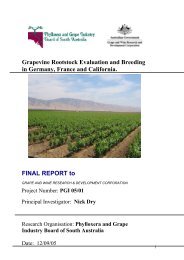Identification of the major drivers of 'phenolic' taste in ... - GWRDC
Identification of the major drivers of 'phenolic' taste in ... - GWRDC
Identification of the major drivers of 'phenolic' taste in ... - GWRDC
Create successful ePaper yourself
Turn your PDF publications into a flip-book with our unique Google optimized e-Paper software.
AWRI: <strong>Identification</strong> Of The Major Drivers Of ‘Phenolic’ Taste In White W<strong>in</strong>es<br />
A.2.2 Selection <strong>of</strong> Solvent System<br />
Two HSCCC solvent systems (mixtures <strong>of</strong> solvents that partition <strong>in</strong>to two phases when mixed) were<br />
selected for screen<strong>in</strong>g and optimisation follow<strong>in</strong>g a review <strong>of</strong> <strong>the</strong> literature. The systems trialled were 1)<br />
hexane, ethyl acetate, methanol and water (HEMBWAT system) and 2) tert-butyl methyl e<strong>the</strong>r,<br />
acetontrile and water (ETAWAT system). Both had previously been used to successfully fractionate<br />
phenolic compounds from natural product extracts, <strong>in</strong>clud<strong>in</strong>g those from w<strong>in</strong>e.<br />
The partition<strong>in</strong>g <strong>of</strong> compounds represent<strong>in</strong>g most <strong>of</strong> <strong>the</strong> <strong>major</strong> phenolic classes <strong>in</strong> white w<strong>in</strong>e were<br />
assessed us<strong>in</strong>g <strong>the</strong> HEMBWAT and ETANWAT solvent systems listed <strong>in</strong> Costa and Leitao (2011),<br />
ordered by <strong>the</strong>ir <strong>the</strong>oretical ability to resolve mixtures <strong>of</strong> polar compounds through to mixtures <strong>of</strong> non-<br />
polar compounds. The phenolics assessed were catech<strong>in</strong> (represent<strong>in</strong>g flavan-3-ols), caffeic acid<br />
(hydroxyc<strong>in</strong>namic acids), chlorogenic acid (hydroxyc<strong>in</strong>namic acids esterified to an organic acid),<br />
quercet<strong>in</strong> (flavonoid) and rut<strong>in</strong> (flavonoid glycoside). The partition<strong>in</strong>g trials suggested that <strong>the</strong><br />
HEMBWAT system <strong>in</strong> <strong>the</strong> ratio (3:7:0:3:7), and <strong>the</strong> ETAWAT system <strong>in</strong> <strong>the</strong> ratio (2:2:3) could be used<br />
to separate <strong>the</strong>se phenolic classes.<br />
A.2.3 Semi-preparative Scale-up<br />
A semi-preparative scale-up was performed us<strong>in</strong>g <strong>the</strong>se two selected systems to assess whe<strong>the</strong>r HSCCC<br />
could be used to adequately separate different phenolic types, both <strong>in</strong> a model system and from a phenolic<br />
extract <strong>of</strong> white w<strong>in</strong>e. 20 mg <strong>of</strong> each <strong>of</strong> <strong>the</strong> phenolic test compounds were <strong>in</strong>jected and run <strong>in</strong>dividually to<br />
determ<strong>in</strong>e <strong>the</strong>ir retention times. The whole phenolics were extracted from 375 mL <strong>of</strong> a McLaren Vale<br />
unwooded Chardonnay us<strong>in</strong>g <strong>the</strong> method described previously was also subjected to HSCCC.<br />
A two phase solvent system was prepared by thoroughly mix<strong>in</strong>g <strong>the</strong> solvents <strong>in</strong> <strong>the</strong> ratios stated above <strong>in</strong><br />
a separat<strong>in</strong>g funnel and allow<strong>in</strong>g it to equilibrate at room temperature. The upper layer was separated<br />
from <strong>the</strong> lower layer and used immediately.<br />
HSCCC was performed us<strong>in</strong>g a Quattro Mk II (AECS-QuikPrep Ltd, Bridgend, S. Wales, UK) equipped<br />
with a 100 mL coil. For <strong>the</strong> HEMBWAT (3:7:3:0:7) system, <strong>the</strong> coil was filled with <strong>the</strong> upper organic<br />
rich phase, and <strong>the</strong> lower aqueous phase was pumped <strong>in</strong>to <strong>the</strong> head end <strong>of</strong> <strong>the</strong> column at a flow rate <strong>of</strong> 1<br />
mL/m<strong>in</strong> with <strong>the</strong> coil rotat<strong>in</strong>g at 800 rpm. For test<strong>in</strong>g <strong>the</strong> ETANWAT (2:2:3) system, <strong>the</strong> coil was filled<br />
with <strong>the</strong> lower phase, and <strong>the</strong> upper phase was pumped <strong>in</strong>to <strong>the</strong> tail end <strong>of</strong> <strong>the</strong> column. After <strong>the</strong> system<br />
reached a temperature <strong>of</strong> 30 o C and hydrodynamic equilibrium had been atta<strong>in</strong>ed, <strong>the</strong> sample was<br />
dissolved <strong>in</strong> 5 mL <strong>of</strong> <strong>the</strong> mobile phase and <strong>in</strong>jected. Two s<strong>in</strong>gle wavelength UV detectors (UPC-900<br />
Amersham Biosciences for 280 nm, Pharmacia Biotech Superfrac GBC LC 1210 for 320 nm) were used<br />
to detect <strong>the</strong> presence <strong>of</strong> phenolics <strong>in</strong> <strong>the</strong> system effluent. Fractions elut<strong>in</strong>g from <strong>the</strong> whole phenolics<br />
were collected every two m<strong>in</strong>utes, and <strong>the</strong>ir composition was assessed by HPLC us<strong>in</strong>g <strong>the</strong> method<br />
described <strong>in</strong> Section A.3.<br />
101




